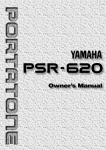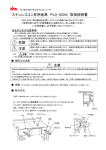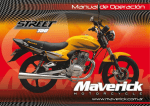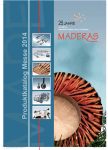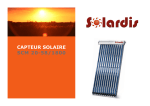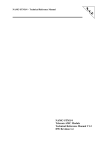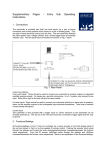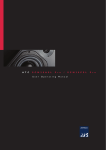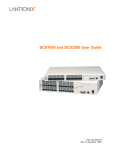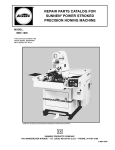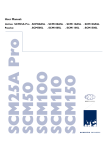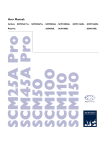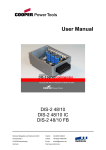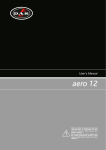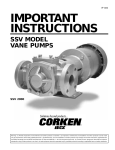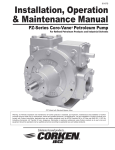Download I&O Manual - Viking Pump Canada
Transcript
Installation, Operation & Maintenance Manual IP 350A SC-Series Multista ge Side Channel Pumps Multistag Mechanically Sealed Model Magnetic Drive Model Warning: (1) Periodic inspection and maintenance of Corken products is essential. (2) Inspection, maintenance and installation of Corken products must be made only by experienced, trained and qualified personnel. (3) Maintenance, use and installation of Corken products must comply with Corken instructions, applicable laws and safety standards (such as NFPA Pamphlet 58 for LP-Gas and ANSI K61.1-1972 for Ahydrous Ammonia). (4) Transfer of toxic, dangerous, flammable or explosive substances using Corken products is at user’s risk and equipment should be operated only by qualified personnel according to applicable laws and safety standards. Warning Install, use and maintain this equipment according to Corken’s instructions and all applicable federal, state, local laws and codes. Periodic inspection and maintenance is essential. Corken One Year Limited Warranty Corken, Inc. warrants that its products will be free from defects in material and workmanship for a period of 12 months following date of purchase from Corken. Corken products which fail within the warranty period due to defects in material or workmanship will be repaired or replaced at Corken’s option, when returned, freight prepaid to CORKEN, INC., 3805 N.W. 36th Street, Oklahoma City, Oklahoma 73112. Parts subject to wear or abuse, such as mechanical seals, blades, piston rings, packing and other parts showing signs of abuse are not covered by this limited warranty. Also, equipment, parts and accessories not manufactured by Corken but furnished with Corken products are not covered by this limited warranty and purchaser must look to the original manufacturer’s warranty, if any. This limited warranty is void if the Corken product has been altered or repaired without the consent of Corken. All implied warranties, including any implied warranty of merchantability or fitness for a particular purpose, are expressly negated to the extent permitted by law and shall in no event extend beyond the expressed warranty period. Corken disclaims any liability for consequential damages due to breach of any written or implied warranty on Corken products. Transfer of toxic, dangerous, flammable or explosive substances using Corken products is at the user’s risk. Such substances should be handled by experienced, trained personnel in compliance with governmental and industrial safety standards. Important notes relating to the European Union (EU) Machinery Directive Pumps delivered without electric motors are not considered as machines in the EU Machinery Directive. These pumps will be delivered with a Declaration of Incorporation. The fabricator of the machinery must assure and declare full compliance with this Directive before the machine in which the pump will be incorporated, or of which it is a part, is put into service. Contacting the Factory Before you contact the factory, note the model number and serial number of your pump. The serial number directs us to a file containing all information on material specifications and test data applying to your specific pump. When ordering parts, the Corken service manual or Operations, Installation and Maintenance manual should be consulted for the proper part numbers. ALWAYS INCLUDE THE MODEL NUMBER AND SERIAL NUMBER WHEN ORDERING PARTS. The model and serial numbers are shown on the nameplate of the unit. Record this information for future reference. Model no. _______________________________________________________________________________________ Serial no. _______________________________________________________________________________________ Date purchased __________________________________________________________________________________ Date installed ____________________________________________________________________________________ Purchased from __________________________________________________________________________________ Installed by ______________________________________________________________________________________ 2 Table of Contents Principle of Side Channel Operation ............................................................................................................................... 5 Exclusive Features of Your Side Channel Pump ............................................................................................................. 6 Installation ...................................................................................................................................................................... 6 Piping .......................................................................................................................................................................... 7 External By-Pass Valve ............................................................................................................................................... 8 Noise Considerations .................................................................................................................................................. 8 Start up ........................................................................................................................................................................ 8 Motor ....................................................................................................................................................................... 8 High Temperature Pumps for Temperatures of 250°F (120°C) and More ................................................................ 9 Operation ........................................................................................................................................................................ 9 Shaft Seal .................................................................................................................................................................... 9 Cooling of the Shaft Seal Housing ............................................................................................................................... 9 Heating of the Shaft Seal Housing ............................................................................................................................... 9 Operation as a Boiler Feed Pump ............................................................................................................................... 9 Coupling .................................................................................................................................................................... 10 Shutdown ..................................................................................................................................................................... 10 Maintenance ................................................................................................................................................................. 10 Bearings .................................................................................................................................................................... 10 Mechanical Seal ........................................................................................................................................................ 10 Single-Acting Mechanical Seals ................................................................................................................................ 10 Double-Acting Mechanical Seals ............................................................................................................................... 10 Coupling .................................................................................................................................................................... 11 Drive/Auxiliary Equipment ......................................................................................................................................... 11 Standby Pumps ......................................................................................................................................................... 11 Disassembly and Assembly Instructions for Mechanically Sealed Model ...................................................................... 11 Disassembly of the Pump .......................................................................................................................................... 11 Mechanical Seal ........................................................................................................................................................ 11 Torque Values Chart .................................................................................................................................................. 12 Assembly of the Pump .............................................................................................................................................. 12 Disassembly and Assembly Instructions for the Magnetic Drive Model ......................................................................... 12 Motor Repair ................................................................................................................................................................. 17 Spare Parts Stock ......................................................................................................................................................... 17 Recommended Spare Parts Stock ............................................................................................................................. 17 Service ......................................................................................................................................................................... 17 Parts Details for SC10 Series ....................................................................................................................................... 18 Parts Details for SC20 Series ....................................................................................................................................... 19 Parts Details for SC30 Series ....................................................................................................................................... 20 Parts Details for SC40 Series ....................................................................................................................................... 21 Parts Details for SC50 Series ....................................................................................................................................... 22 Parts Details for SC60 Series ....................................................................................................................................... 23 Piping Tips .................................................................................................................................................................... 24 Appendix A Model Number & Materials Selection for SC Models ................................................................................................. 26 Model Number & Materials Selection for SCM Models .............................................................................................. 27 Appendix B Technical Specifications ............................................................................................................................................ 28 Appendix C Performance Curves ................................................................................................................................................. 29 Appendix D Outline Dimensions for SC Models ............................................................................................................................ 32 Outline Dimensions for SCM Models ......................................................................................................................... 33 Appendix E Troubleshooting Guide .............................................................................................................................................. 34 3 Table of Contents (continued) Appendix F Stage Arrangement .................................................................................................................................................... 36 Appendix G Extended Storage Procedures for Mechanically Sealed Model ................................................................................. 37 Appendix H Magnetic Drive Technical Specifications .................................................................................................................... 37 Magnetic Drive Material Specifications ...................................................................................................................... 37 Magnetic Drive Cautions ........................................................................................................................................... 37 Magnetic Drive Storage Procedures .......................................................................................................................... 37 4 to the liquid through the exchange of momentum, thus allowing the pump to build pressure. Principle of Side Channel Operation The side channel leads directly to the outlet port (F). At the outlet port, the main channel ends and a smaller minichannel (G) begins. At the point where the mini-channel ends, there is a small secondary discharge port (H) level with the base of the impeller blades. The design of the side channel pump allows for the transfer of liquid-gas mixtures with up to 50% vapor; therefore eliminating possible air or vapor locking that can occur in other pump designs. A special suction impeller lowers the NPSH requirement for the pump. As the liquid is forced to the periphery through centrifugal action due to its density, the vapor within the liquid stream tends to remain at the base of the impeller blades since it has a much lower density. The main portion of liquid and possibly some vapor, depending on the mix, is discharged through the outlet port. A small portion of the liquid flow follows the mini-channel and eventually is forced into the area between the impeller blades. The remaining vapor which was not drawn through the outlet port resides at the base of the impeller blades. At the end of the minichannel, as the liquid is forced into the area between the blades, the area between and around the impeller blade is reduced. The liquid between the blades displaces and thus compresses the remaining vapor at the base of the impeller blades. The compressed vapor is then forced through the secondary discharge port where it combines with the liquid discharged through the outlet port as it is pulled into the next stage or discharged from the pump. Thus entrained vapor is moved through each stage of the pump. The side-channel pump design is similar to a regenerative turbine in that the impeller makes regenerative passes through the liquid. However, the actual design of the impeller and casing as well as the principles of operation differ greatly. The side-channel pump has a channel only in the discharge stage casing (A) and a flat surface which is flush with the impeller on the suction stage casing (B). A star-shaped impeller (C) is keyed to the shaft and is axially balanced through equalization holes (D) in the hub of the impeller. The liquid or liquid/vapor mixture enters each stage of the pump through the inlet port (E). Once the pump is initially filled with liquid, the pump will provide a siphoning effect at the inlet port. The effect is similar to what happens in water ring pumps. The water remaining in the pump casing forms a type of water ring with a free surface. A venturi effect is created by the rotation of the impeller and the free surface of the water, thus pulling the liquid into the casing. Each subsequent stage operates under the same principle. The number of stages can be varied to meet the required discharge head. When multiple stages are required, the relative positions of the stage outlet ports are radially staggered to balance shaft loads. After the liquid is pulled through the inlet port, it is forced to the outer periphery of the impeller blade by centrifugal action. It is through this centrifugal action that the liquid is accelerated and forced into the side channel. The liquid then flows along the semicircular contour of the side channel from the outermost point to the innermost point until once again it is accelerated by the impeller blade. The liquid moves several times between the impeller and the side channel. Thus the rotating impeller makes several regenerative passes until the liquid reaches the outlet port. The speed of the impeller along with the centrifugal action impart energy F G Item Liquid-vapor mixture A Vapor Liquid 5 Description A Discharge Stage Casing B Suction Stage Casing C Impeller D Equalization Holes E Inlet Port F Outlet Port G Mini-Channel H Secondary Discharge Port are 100% flush. They should be approximately 0.08 to 0.12 inches or 2–3 mm apart (see Figure 2). Exclusive Features Of Your Corken Side Channel Pump The Corken SC pump line utilizes an integral centrifugal impeller, multi-stage impellers in series and side channel design to allow for the following features: a1 b1 Parallel < 0.015 inch (0.381 mm) a • Self-priming capability b • High differential pressure capacity at relatively low flow • Low NPSH requirements 0.079-0.118 (2-3 mm) • Pumping of up to 50% entrained vapor without cavitation Angular < 0.060 inch (1.524 mm) a = a1 and b = b1 • Non-pulsating flow Figure 2 • Multiple sealing options, including magnetic drive, as well as multiple materials options providing maximum flexibility for a wide range of industrial applications. Never mount couplings using force (e.g. blows with a hammer). After completing the foundation and connecting the piping, check alignment of the coupling once more and realign, if required. • Modular design minimizes the need for spare parts and makes assembly and disassembly easier. Installation WARNING: Couplings are aligned at the factory but should be checked after installation and before start up. Transportation Misalignment may occur due to handling and installation. The pump must be transported as illustrated in Figure 1. DO NOT lift the unit by the eye rings on the motor. A protective guard needs to be installed to prevent someone coming into contact with the coupling during operation. For liquids in excess of 250°F (120°C) and below -40°F (-40°C), the pump has to be fitted with a support sleeve on the side opposite the drive side to account for thermal expansion. Fit the pump with a pressure gauge on both suction and discharge sides. Install a throttle valve on the discharge side in order to maintain the exact delivery head (see rating plate). Figure 1 Performance of the side channel pump depends on the clearance between each impeller and stage casing (between 0.006 and 0.007 inches or 0.152–0.178 mm wide). Due to the narrow clearances the pump is not suitable for delivery of liquids containing solids with a grain size larger than 100 mesh. In all cases a strainer must be installed on the suction side, to prevent foreign matter from damaging the impellers and casings. Place the pump and driver evenly and free from stresses onto the base plate. Leave flange covers in place until the piping is connected. If the motor is not preinstalled with the pump, the set must be aligned at installation. To do this, make sure the two coupling halves 6 Make sure the pump is always filled with the pumping liquid to maintain the self-priming feature. Use a back flow check valve to stop reverse flow when operating with suction lift (see Figure 3). Do not use the pump or it’s mounting as an anchorage point for pipelines. Connect all pipes making sure that no forces/ moments resulting from the system can be transmitted to the pump or driver. Any stresses resulting from temperature fluctuations must be minimized. At a temperature in excess of 250°F (120°C), suction and discharge lines are to be fitted with compensators or expansion joints to account for thermal expansion. Check valve Make sure all pipes are completely clean before startup. Gaskets must be perfectly flush with the inside walls. Check all connections for leakage. Below liquid line Do not use small angle bends in the suction or discharge lines. Suction line: To ensure disturbance-free continuous operation, the inflow conditions of the plant have to be adjusted to the suction requirements of the pump (NPSHR). Figure 3 With higher delivery heads (i.e. > 65 ft. or 19.8 m), long pipelines, parallel operation and/or backpressure from the plant (system pressure), use a back flow check valve on the discharge side to prevent reverse flow of the liquid through the pump when it is shut down (see Figure 4). The maximum suction lift is 23 ft. (7.0 m) for water (cold). Please keep in mind that fluids with a low vapor pressure also have a smaller suction lift. Pay close attention to the suction head or NPSH-value of liquids pumped at or near their boiling point, because flashing could occur and cause the pump to cavitate, which in turn, could severely damage the internal parts. Balance line The decisive factors for determining the NPSHR available are temperature, vapor pressure, density, suction head and pipe loss (See Appendix C to find the NPSHR of your application). Check valve EXCEPTION: SC operating with suction lift: The suction and discharge lines are to be the same diameter. Provide a steadying distance before the pump with a length measuring 10 times the pipe diameter (see Figure 5). Figure 4 Connecting eccentric pipe After completing installation of the pump, check all piping and connections for leakage. Check the pump for freedom of movement. It should be possible to rotate the shaft of smaller sized pumps by hand. Check the operating safety of the entire pumping plant on the basis of the applicable accident prevention regulations (electrical connections, coupling guard etc.). Steadying distance 10D Piping Always point eccentric reducers downward All pumps come filled with an anti-rust agent that will have to be removed before connecting the pump to the piping. Dispose of this fluid according to local regulations. Figure 5 The direction of flow through the pump is indicated by arrows on the pump casing. 7 With suction lift operation, place the suction strainer at least 6 inches below the minimum liquid level as shown in Figure 3. • Insert a rubber connecting piece between the pump and piping both in the suction and the discharge line. With positive suction operation from a tank under vacuum, it is advisable to place a vacuum balance line in the piping as shown in Figure 4. • Pipelines should not be in direct contact with walls, ceilings or floors. • If necessary, place pump (not motor!) inside a soundproof enclosure. To maintain the self-priming feature of the pump, it must be filled with liquid at all times. Start up Discharge line: FIII the pump with the liquid to be pumped and vent it by means of the vent ports on the flanges. Pumps with balanced or un-balanced mechanical seal construction must be vented too, by means of threaded seal housing plugs. Venting is also necessary In case of positive suction and for hot liquids. This Is only done once and could, for example, take place before connecting up the piping. For all subsequent startups the pump will take up suction operation automatically. The discharge pipe should be sized so that its diameter is at least as large as the cross-section of the pump discharge flange. External By-Pass Valve The Corken side channel pump is not equipped with an internal relief valve, therefore it is essential that some type of external by-pass or hydrostatic relief valve be installed in the discharge side of the system as close to the pump as possible. The by-pass valve, while acting as a relief, also guards against excessive differential pressures in the pumping system to protect the pump, piping, and system components. Corken recommends using our B166 by-pass valve, for flows up to 40 gpm (151.4 L/min), and pressures up to 225 psid (15.5 bar d), as it has the added benefit of a vapor eliminator that prevents vapor lock upon start up. This is especially helpful when pumping liquefied gases, such as propane or ammonia. Consult Corken for more details. The pump must be supplied with liquid at all times and must never run dry! Mechanical seals are destroyed with only a few seconds of dry running. The power requirement increases with increasing head and decreasing flow rate. Never run the pump with the suction and/ or discharge line closed! Dead heading the pump can cause impeller teeth to bend or break and can lead to shaft deflection. Open all shutoff valves in the suction and discharge lines! Noise Considerations If the unit is fitted with a bypass line, see that it is closed for suction lift operation, with positive suction operation it may remain open. A certain amount of noise during the operation of self-priming centrifugal pumps cannot be avoided. Nevertheless our patented pump has a very low noise level owing to the speed of operation and its special design features. Depending on the pump size, the noise level of our pumps range between 60 and 80 dBA. However, the reason for the noise is not always to be found in the pump. Other possible sources of noise are as follows: The bearings are sealed and do not require lubricating and are ready for operation. Motor Check the operating voltage and speed of the motor. • Driver, motor or engine The speed of the 50 Hz model is 1450 RPM and the speed of the 60 Hz model is 1750 RPM or 1150 RPM. NOTE: The minimum speed of a side channel pump is 900 RPM and the maximum is 1800 RPM. • Improperly installed coupling • Other apparatus in the same room (e.g. heating system, water main, taps or valves. Flowing water always produces noise (e.g. water hammer). The velocity of the water should be kept as low as possible: between 3 and 7 feet per second (0.9 and 2 m), at the most 10 feet per second (3 m). Further possibilities of reducing the flow velocity and thereby limiting quantity of out flowing water are generously dimensioned pipelines and the use of regulators and other devices. Use a motor overload protection switch! Check the direction of rotation of the motor by switching the motor on and then off again immediately. The direction of rotation of the pump is indicated on the pump casing. Never run the pump against the specified direction of rotation! If the pump is the source of most of the noise, the following measures will reduce the noise level: The electrical connections are to be made by an authorized electrician and in compliance with local regulations, in particular in respect to the safety measures to be performed. • Place the pump on rubber cushions (buffers). Switch the pump on with the shutoff valves open. 8 The valves incorporated in the suction line must also be open! Cooling of the Shaft Seal Housing Cooling of the shaft seal housing is required when the temperature of the liquid to be pumped exceeds 250°F (120°C). The cooling water requirement depends on the temperature of the pumping liquid and on the pump size: it is about 0.50 gpm (1.9 L/min) at maximum 145 psi (10 bar). The cooling liquid enters the housing in the upper section of the pump foot, whereas it drains off diagonally across on the opposite side (see Figure 7). Close bypass line. Once the pump has reached full speed (rated speed indication on the rating plate), adjust the delivery head by slowly closing the valve on the discharge side. The time required for suction to start depends on the length of the suction line and will take several seconds at first startup. If the suction line is fitted with a foot or non-return valve, delivery will start immediately the second time the unit is switched to the on position. High Temperature Pumps for Temperatures of 250°F (120°C) and More If the pump is to be used for delivering hot liquid, make sure the pump is not affected by thermal shock. Shocks of this nature in a cold pump are only permissible without additional protective measures for a temperature of 250°F (120°C), maximum. After a thermal shock, check for free rotation of the pump by manually turning the coupling. Wait between one and two minutes until the pump has heated up. The hot pump can now be switched on. Figure 7 Heating of the Shaft Seal Housing When pumping liquids that tend to become crystalline in the temperature range of pump operation or form incrustations or sticky deposits on the shaft seal, we recommend wetting of the shaft seal housing with a heating liquid from an external source. The heating liquid enters in the bottom section of the pump foot, whereas it drains off diagonally across in the upper section of the foot (see Figure 8). The heating liquid quantity depends on the pump size and the size of the temperature difference and amounts to approximately 0.50 gpm (1.9 L/min) at a maximum of 145 psi (10 bar). Tighten the tie bolts of the casing opposite the drive side, but only so much that the pump feet can still move in the direction of the longitudinal pump axis. We recommend that you use a support sleeve (see Figure 6). Figure 6 Operation Shaft Seal Figure 8 Mechanical seals do not require maintenance and do not leak during operation. On pumps with double-acting mechanical seals, the sealing chamber is to be wetted with sealing liquid. The pressure of the sealing/purging liquid is to be kept at between 15 to 30 psi (1–2 bar) above the pressure at the discharge nozzle of the pump. During the initial starting phase (approximately 50 hours) the temperature of the mechanical seal is to be monitored. It should never exceed the temperature of the liquid to be pumped by more than approximately 59°F (15°C); its maximum temperature is 176°F (80°C). Operation as a Boiler Feed Pump When the pump is employed as a boiler feed pump, care must be taken that it is not run at a lower operating pressure than specified. lf the feed tank is operated at a lower operating pressure for any length of time, the pump discharge pressure must be reduced to the normal operating pressure of the tank by means of a hand-operated shutoff valve and a pressure gauge fitted at the discharge nozzle of the pump casing. 9 Coupling Flushing the seal As soon as the flexible elements of the shaft connection show signs of wear (abrasion), these parts have to be replaced. Verify the alignment of the shaft ends. Used to flush the seal Shutdown 1. Do not close the shut off valve on the discharge side until the pump has come to a complete standstill. 2. Switch off the driver. Figure 9 3. The shutoff valve can remain open if back check valves are installed. Double-Acting Mechanical Seals 4. The shut off valve on the suction side is to be closed both during prolonged standstill of the pump or it fhere is an overpressure on the suction side (positive suction). Double-acting mechanical seals require sealing liquid to function properly. The purpose of this liquid is to dissipate the friction heat and keep the product from entering the sealing clearance. The sealing liquid fills the space between the two mechanical seal assemblies—one on the product side and the other in contact with the atmosphere. 5. Shut down all auxiliary facilities (cooling liquid, etc.). The shaft seal on the pumps pumping liquid under vacuum has to remain wetted by the sealing liquid during shutdown. Any liquid can serve as a sealing medium as long as the corrosion-resistance of the parts that come in contact with it are taken into consideration. The sealing liquid must not contain any solid particles or be liable to form deposits and it should have a high boiling point as well as good thermal conductivity properties. Clean water of low hardness meets these requirements to a high degree. The sealing liquid pressure should exceed the pressure of the medium to be sealed by 15 to 30 psi (1–2 bar). 6. If there is a danger of frost, protect the pump, cooling circuit, etc. against freezing or drain off the liquid. Maintenance Bearings The pump requires only very little maintenance once it has been started up. The external antifriction bearings are also maintenance-free and filled with grease for the life of the bearing. It is not necessary to re-grease the closed bearings. If the pump is operated according to the specified duty data and these instructions. the first bearing change is only necessary after approximately 8,000 to 10,000 hours of operation, and can last longer in cases of flooded suction and/or a self lubricating liquid. The internal carbon bearings are then replaced as well. The outlet temperature should at the most be approximately 140°F (60°C), or remain 104°F (40°C) below the boiling point of the sealing liquid at normal pressure. To prevent the possible formation of gas bubbles, place the sealing liquid inlet at the bottom connection of the discharge casing and the outlet at the shaft seal housing (see Figure 10 ). View from the driver Mechanical Seal Mechanical seals do not leak or require maintenance. However, make sure they never run dry during operation and that the operating conditions remain within the set limits of the mechanical seal in question. In the event of leakage, the mechanical seal cannot be re-tightened. In this case we recommend dismantling the mechanical seal and checking the rotating ring, the shaft, the o-ring and the counter ring. Single-Acting Mechanical Seals This type of single mechanical seal offers the possibility of internal flushing through a borehole in the casing (see Figure 9). In addition, the pump can be fitted with an external circulation pipe. This is fixed onto the shaft seal casing at the position of the threaded plug. This plug serves also for venting of the shaft seal chamber. Figure 9 10 gasket and take care not to damage it. Always use new stage gaskets when practical. Make absolutely sure to wet the mechanical seals with sealing liquid prior to start up. With low operating pressures, the water main is all that is required to establish a sealing pressure system. For higher pressures we recommend a sealing pressure system incorporating a gravity circuit, which is suitable for an operating pressure of up to 435 psi (30 bar). 4. Flatten the lock washer on the shaft nut. 5. Loosen the shaft nut. The nut has left hand threads and must be turned clock-wise to remove. Then remove the lock washer. Coupling The coupling is used as a point of reference to check whether the motor shaft is still in alignment with the pump shaft. This check is to be performed after approximately 1000 hours of operation. Check the rubber coupling buffers installed in the coupling used for this pump. In case of heavy wear the motor will no longer be in alignment with the pump. This normally results in bearing damage. 6. Remove the NPSH suction impeller and shaft key. This impeller should pull off with little resistance. Remove the shaft sleeve. Drive/Auxiliary Equipment 9. Remove the stage impeller. This is a free-floating impeller, but will take more resistance to remove than the NPSH impeller. If prying is necessary be very careful not to damage any parts. Then remove the shaft key. 7. Remove the NPSH suction casing. 8. Remove the suction stage casing. The manufacturers operating instructions are applicable. Standby Pumps Put the pump into operation regularly once a week for a short peroid of time to make sure it remains ready for operation and to avoid, among other things, the possible formation of corrosion. 10. Remove the discharge stage casing. 11. Repeat steps 9–11 until all stages have been removed. 12. To re-assemble complete steps in reverse order. Disassembly and Assembly Instructions for Mechanically Sealed Models NOTE: When re-ordering stage gaskets for the pump refer to the fourth digit in the model number. This indicates the number of stages. For example, an SC15WC2AG12 pump would have five stages. Add one to this number and multiply by two. For example, a five stage pump would use twelve stage gaskets (5+1x2=12). During the term of warranty the pump may only be dismantled by Corken, Inc. or by one of the authorized workshops. Mechanical Seal Disassembly of the Pump The mechanical seal in the pump is maintenance free. If leakage is detected over a longer period of time, the mechanical seal must be replaced. To do this, the pump does not necessarily have to be removed from the baseplate, nor does the piping have to be dismantled. After the term of warranty has ended, the pump should only be dismantled by adequately trained personnel. Before dismantlng, mark the individual casing components so they can be reassembled in the correct order and orientation in relation to each other. To repair the pump, it must be disconnected from driver, baseplate and piping and follow the steps listed below. To fit a new mechanical seal, proceed as follows: Be sure the unit is secured, can not be switched on, and the inlet and discharge valves are closed. 1. Although pump stage casings and impellers are interchangeable it is good practice to consecutively number all stages and draw a straight line down the length of the pump. The stages are set in a specific position (either 120° or 180° apart) and must be reassembled in the same position (see Appendix G). It is not required to remove the pump from the baseplate or to disassemble piping. The design enables the mechanical seal to be replaced while the pump is still installed. The motor, however, must be removed from the baseplate. 1. On the pump side, remove the coupling half, loosen the two flat head screws and remove the bearing cover. 2. It is best to work on the pump with it in the vertical position. With the drive end facing down, put the feet in a vise to assist in doing this. The pump can be disassembled from the suction or drive end. Typically it is done from the suction end to avoid disrupting the mechanical seal. 2. Remove the retainer ring. 3. Remove the four hexagonal screws that secure the bearing bracket. 3. With suction flange upward, loosen the six tie rod bolts and remove the suction flange. Note the green casing 11 4. Pull the bearing bracket together with the roller bearing away from the shaft. NOTE: the bearing is pressed on the shaft and therefore will be hard to remove by hand. It is recommended that a puller be used to aid in this task. 3. When mounting the impellers, slide these along the shaft until they about on the stage casing shrouds. 5. Strip off the thrower. 5. After completing pump reassembly, it should be possible to rotate the pump shaft easily by hand. 4. Tighten the tie bolts with a torque wrench. 6. Remove the four hexagonal nuts from the studs and pull the seal housing with the stationary seat, which is inside it, away from the casing seat. 6. The individual stage casing assemblies have been staggered in relation to each other to better absorb the radial forces of the pump. It is, therefore, of great importance to reassemble these stage casing assemblies in their original, staggered, position in relation to each other. 7. Remove the mechanical seal from the shaft. Important: When removing or installing the mechanical seal, make sure that the o-ring is not damaged by the grooves on the shaft. Disassembly and Assembly Instructions for Magnetic Drive Models 8. After replacing the mechanical seal, re-assemble the pump in reverse order. Torque Values Assembly of the Pump After the term of warranty has ended, the pump should only be dismantled by adequately trained personnel. Before dismantlng, mark the individual casing components so they can be reassembled in the correct order and orientation in relation to each other. To repair the pump, it must be disconnected from driver, baseplate and piping and follow the steps listed below. Tie Bolts Model Series Torque 1. Although pump stage casings and impellers are interchangeable it is good practice to consecutively number all stages and draw a straight line down the length of the pump. The stages are set in a specific position (either 120° or 180° apart) and must be reassembled in the same position (see Appendix G). ft•lb (N•m) SC/SCM10 23 (31) SC/SCM20, SC/SCM30 29 (39) SC/SCM40 35 (48) SC/SCM50 44 (60) SC/SCM60 80 (108) 2. It is best to work on the pump with it in the vertical position. With the drive end facing down, put the feet in a vise to assist in doing this. The pump can be disassembled from the suction or drive end. Shaft Bolt Model Series 3. See Appendix H for cautions on operating safety and handling of the magnetic drive coupling. Torque ft•lb (N•m) SC/SCM10 35 (48) All others 55 (75) The pump is re-assembled in reverse order and in accordance with the identification marks made on the components before disassembly. Pay special attention to the following: 1. Parts that are to be used again must be cleaned well. 2. Remaining bits of gasket must be removed and new gasket used. 12 Step 1 - Assemble the Bearing Unit a. Start with the small drive shaft. Using a press install the sealed ball bearing on the drive side first. (Note: the two ball bearings are interchangeable.) Secure to shaft using the retainer clip. Ref. No. Description Qty 1 Retainer clip 1 b. Place the shaft and bearing assembly into the bearing housing and install the bearing cap using 3 screws. 2 Bearing casing 1 3 Front support foot 1 c. Flip the bearing housing over and install the other ball bearing using a press. Secure using the retainer clip. NOTE: To disassemble the bearing housing assembly remove the bearing cap, both retainer rings and press the shaft out of the bearing housing from the drive side first. 4 Cap screw 1 5 Key 1 6 Driving shaft 1 7 Woodruff key 1 d. Once the bearing assembly is complete, place in a vise drive side down. Make sure a helicoil is in the end of the shaft. 8 Ball bearing 2 9 Retainer clip 1 10 Bearing cap 1 11 Cap screw 3 e. Insert the shaft key and test fit the outer rotor adapter plate, and then remove plate. 1 8 2 8 3 4 5 6 13 7 9 10 11 Step 2 - Assemble Magnetic Coupling with Bearing Unit Ref.No. Description a. Place outer magnet housing on the bearing assembly and tighten using four screws. Note the location of the 1/4” NPT hole and make sure it is facing the top left of the pump. Qty 1 Bolt 1 2 Washer 1 3 Outer mag drive 1 b. Assemble the rotor adapter plate to outer magnetic drive rotor. The outer mag drive rotor also uses helicoils. 4 Rotor adapter plate 1 5 Cap screw 4 c. Place outer magnetic rotor assembly into the magnetic housing and align with key in shaft. Secure with washer and screw. Hold the lower shaft so it does not turn when tightening the screw. 6 Magnetic housing 1 7 Cap screw 4 1 2 3 4 5 14 6 7 Step 3 - Assemble Shaft with Magnetic Bearing Unit a. Insert helicoil into the mag end of the pump shaft. b. Place the shaft in a vise, mag end up and insert the small dowel pin. c. Place the thrust bearing on shaft, making sure to align the notch on the dowel pin. Ref.No. Description Qty d. Attach sleeve-bearing housing to adapter plate using 5 bolts. High-pressure pumps have two bearings and lowpressure pumps have one bearing. If your pump has two bearings protect the lower bearing from the underneath side so it will not fall out. 1 Pump shaft 1 2 Key 1 3 Adapter ring 1 4 Gasket 1 e. Apply a small amount of Vaseline to the bearing face and insert the pump shaft into the adapter plate and place vertically in the vise. 5 Shaft sleelve 1 6 Sleeve bearing 1 7 Cap screw 5 f. Slide the long carbon or steel (depending on model) shaft sleeve on to the shaft and insert the non-metallic key into the shaft. 8 Thrust bearing 1 9 Inner mag drive 1 10 Cap screw 4 11 Washer 1 12 Hex head screw w/hole 1 13 Separation chamber 1 14 Cap screw 16 g. Slide the inner magnetic drive rotor on to the shaft and secure using the washer and bolt that has the hole drilled through it. Torque to prescribed value. h. Insert the separation chamber gasket on the adapter ring and install the separation chamber. CAUTION: Chamber will resist at first and then slam onto the plate. Secure using 16 screws. 3 1 4 5 6 2 15 7 8 9 10 11 12 13 14 Step 4 - Assemble shaft unit with bearing unit Ref.No. Description a. Return the magnet housing to the vise and secure it vertically. Next lower the shaft assembly into the casing and tighten using 8 screws. This completes the magnetic end of the pump. 1 Adapter ring 1 2 Magnetic housing 1 3 Cap screw 4 2 1 Qty 3 Step 5 - Assemble hydraulic parts with magnetic bearing unit a. Place the smaller gray gasket onto the mag assembly and install the discharge casing. Ref.No. Description Qty 1 Suction stage casing as req b. Install the green stage gasket and discharge stage casing. Make sure the notch on the outside of the casing is correctly positioned. 2 Impeller as req 3 Discharge stage casing as req 4 Stage bushing as req c. Install the half moon key and impeller. The impeller should slide easily onto the key. 5 Stage gasket as req 6 Discharge casing 1 7 NPT plug 1 8 Gasket 1 9 Woodruff key 1 d. Install another green stage gasket and the suction stage casing, again noting the location of the outer casing notch. e. Repeat steps a. through d. until all stages of the pump are assembled. 1 2 3 4 5 6 7 8 9 16 Step 6 - Assemble NPSH end to pump unit Ref.No. Description a. The last stage you will install is the NPSH stage and impeller. This impeller looks like a centrifugal impeller. Also install steel sleeve bushing. Qty 1 Nut 6 2 Washer 6 3 Tie bolt 6 4 Suction casing 1 5 NPT plug 1 6 Shaft nut 1 7 Lock washer 1 8 Suction impeller 1 9 Suction impeller shaft sleeve 1 d. Install the six tie bolts and snug up the nuts. 10 Stage gasket 1 e. Lay the pump horizontally on a flat surface and make sure the flanges and feet are level. Tighten the six tie bolt nuts evenly using a star pattern. 11 Suction impeller casing 1 12 Suction impeller sleeve 1 13 Stage gasket 1 14 Suction stage casing 1 b. Secure to shaft using washer and nut. Please note that this is a left-handed thread and screws on backwards. Torque to the prescribed value and bend washer up to lock the nut. NOTE: In some cases the magnets might de-couple while torqueing. At this point the nut is tight enough and should not be torqued further. c. Install the suction flange using a green gasket. 1 2 3 4 5 6 7 8 9 10 11 12 13 14 4. Optional parts: Motor Repair Suction and discharge casing Repairs to electrical components must only be performed by an authorized electrician. Impeller Spare Parts Stock NPSH bushing Service Please always quote the following information when ordering spare parts: During the term of warranty the pumps may only be dismantled by an authorized workshop. Therefore, if service is required send your pump(s) to the nearest authorized service agent. Contact the factory for a listing in your area. This service is still available after the warranty term has expired. Model number and serial number that is listed on the nameplate. Recommended Spare Parts Stock We recommend the following spare parts per pump. Critical applications should stock more or have a standby pump. 1. Seal assembly and seal housing gasket 2. Stage gasket 3. Ball bearing and stage bushing 17 Part Details for SC10 Series 1 Illustration to the left contains single unbalanced seal (part #31-A). Optional seals are shown below. Single Balanced Seal 31-B 31-A1 Double Unbalanced Seal 31-C Double Balanced Seal Buffer fluid connection for double seal configuration (1/4" straight connection) Item 1 2 3 4 5 6 7 8 9 Part No. 5742 5600 5741 5660 5703 5604 5919 5702 5701 5762 5679 N/A N/A N/A 5602 5640 5681 5721 5648 5724 5991 10 5814 5699 5813 5812 5683 11 12 Consult F. 5700 5674 5682 Consult F. 5868 5890 5889 5722 5888 Description Suction casing with plug, cast iron Suction casing with plug, ductile iron Suction casing with plug, stainless Suction impeller, bronze Suction impeller, stainless Stage gasket Suction impeller shaft sleeve Suction impeller sleeve bearing Suction impeller case, cast iron Suction impeller case, ductile iron Suction impeller case, stainless First stage suction case, cast iron First stage suction case, ductile First stage suction case, stainless Impeller, brass Impeller, steel Impeller, stainless Stage imp. sleeve bearing, bronze Stage imp. sleeve bearing, carbon Stage imp. sleeve bearing, high temperature (prior to and including s/n: 9701448/1) Stage imp. sleeve bearing, high temperature (After s/n: 9701448/1) Discharge stage case, cast iron, bronze bearing Discharge stage case, cast iron, carbon bearing Discharge stage case, ductile iron, bronze bearing Discharge stage case, ductile iron, carbon bearing Discharge stage case, stainless steel, carbon bearing High temperature models Suction stage case, cast iron Suction stage case, ductile iron Suction stage case, stainless Suction stage case, high temperature Shaft assembly, one stage, iron Shaft assembly, one stage, stainless Shaft assembly, two stage, iron Shaft assembly, two stage, stainless Shaft assembly, three stage, iron Cooling connection used with cooling option (1/8" straight connection) Item 12 Description Shaft assembly, three stage, stainless Shaft assembly, four stage, iron Shaft assembly, four stage, stainless Shaft assembly, five stage, iron Shaft assembly, five stage, stainless Shaft assembly, six stage, iron Shaft assembly, six stage, stainless Shaft assembly, seven stage, iron Shaft assembly, seven stage, stainless Shaft assembly, eight stage, iron Shaft assembly, eight stage, stainless 13 Discharge case, cast iron Discharge case, ductile iron Discharge case, stainless 14 Discharge case O-ring (high temperature only) 15 Foot O-ring (high temperature only) 16 Foot, standard models Foot, high temperature models 17 Seal housing, iron Seal housing, stainless 18 Bearing bracket 19 Spacer sleeve 20 Ball bearing, standard Ball bearing, high temperature 21 Retainer ring 22 Bearing cover 23 Cover screw 24 Bearing bracket screw 25 Seal housing hex nut 26 Stud bolt 27 Seal housing gasket 28 Seal locator ring (unbalanced only) 29 Seal locator sleeve with O-ring (balanced only) 30 Tie rod 31 Mechanical seal a) single unbalanced 5605-XA_ _2 b) single balanced 5605-XB_ _2 c) double unbalanced 5605-XC_ _2 d) double balanced 5605-XD_ _2 2 Refer to the 9th and 10th digit of the pump model number. 18 Part No. 5887 5886 5684 5885 5884 5883 5882 5881 5880 5879 5878 5754 5753 5752 2-2049A 2-2086A 5835 5834 5923 5924 5902 5649 5603 5725 5650 5651 Consult F. 5935 5933 5932 5661 5662 5978-XA Consult F. 31-D Part Details for SC20 Series 1 Illustration to the left contains single unbalanced seal (part #31-A). Optional seals are shown below. Single Balanced Seal 31-B 31-A1 Double Unbalanced Seal 31-C Double Balanced Seal Buffer fluid connection for double seal configuration (1/4" straight connection) Item 1 2 3 4 5 6 7 8 9 Part No. 5707 5740 5739 5720 5733 5615 5695 5694 5712 5761 5760 5716 5784 5783 5613 5643 5731 5766 5696 5730 5994 10 5811 5715 5810 5809 5808 11 12 Consult F. 5714 5792 5791 Consult F. 5877 5732 5876 5875 5874 Description Suction casing with plug, cast iron Suction casing with plug, ductile iron Suction casing with plug, stainless Suction impeller, bronze Suction impeller, stainless Stage gasket Suction impeller shaft sleeve Suction impeller sleeve bearing Suction impeller case, cast iron Suction impeller case, ductile iron Suction impeller case, stainless First stage suction case, cast iron First stage suction case, ductile First stage suction case, stainless Impeller, brass Impeller, steel Impeller, stainless Stage imp. sleeve bearing, bronze Stage imp. sleeve bearing, carbon Stage imp. sleeve bearing, high temperature (prior to and including s/n: 9701448/1) Stage imp. sleeve bearing, high temperature (after s/n: 9701448/1) Discharge stage case, cast iron, bronze bearing Discharge stage case, cast iron, carbon bearing Discharge stage case, ductile iron, bronze bearing Discharge stage case, ductile iron, carbon bearing Discharge stage case, stainless steel, carbon bearing High temperature models Suction stage case, cast iron Suction stage case, ductile iron Suction stage case, stainless Suction stage case, high temperature Shaft assembly, one stage, iron Shaft assembly, one stage, stainless Shaft assembly, two stage, iron Shaft assembly, two stage, stainless Shaft assembly, three stage, iron Cooling connection used with cooling option (1/8" straight connection) Item 12 31-D Description Shaft assembly, three stage, stainless Shaft assembly, four stage, iron Shaft assembly, four stage, stainless Shaft assembly, five stage, iron Shaft assembly, five stage, stainless Shaft assembly, six stage, iron Shaft assembly, six stage, stainless Shaft assembly, seven stage, iron Shaft assembly, seven stage, stainless Shaft assembly, eight stage, iron Shaft assembly, eight stage, stainless 13 Discharge case, cast iron Discharge case, ductile iron Discharge case, stainless 14 Discharge case O-ring (high temperature only) 15 Foot O-ring (high temperature only) 16 Foot, standard models Foot, high temperature models 17 Seal housing, iron Seal housing, stainless 18 Bearing bracket 19 Spacer sleeve 20 Ball bearing, standard Ball bearing, high temperature 21 Retainer ring 22 Bearing cover 23 Cover screw 24 Bearing bracket screw 25 Seal housing hex nut 26 Stud bolt 27 Seal housing gasket 28 Seal locator ring (unbalanced only) 29 Seal locator sleeve with O-ring (balanced only) 30 Tie rod 31 Mechanical seal a) single unbalanced 5616-XA_ _2 b) single balanced 5616-XB_ _2 c) double unbalanced 5616-XC_ _2 d) double balanced 5616-XD_ _2 2 Refer to the 9th and 10th digit of the pump model number. 19 Part No. 5873 5872 5871 5713 5870 5644 5869 5867 5866 5865 5864 5751 5750 5749 2-2060A 2-2131A 5645 5763 5925 5764 5901 5718 5614 5687 5717 5899 Consult F. 5934 5933 5931 5642 5708 5719-XA Consult F. Part Details for SC30 Series 1 Illustration to the left contains single unbalanced seal (part #31-A). Optional seals are shown below. Single Balanced Seal 31-B 31-A1 Double Unbalanced Seal 31-C Double Balanced Seal Buffer fluid connection for double seal configuration (1/4" straight connection) Item 1 2 3 4 5 6 7 8 9 Part No. 5707 5740 5739 5720 5733 5615 5695 5694 5712 5761 5760 5716 5784 5783 5613 5643 5731 5766 5696 5730 5994 10 5807 5806 5805 5804 5803 11 12 Consult F. 5714 5792 5791 Consult F. 5877 5732 5876 5875 5874 Description Suction casing with plug, cast iron Suction casing with plug, ductile iron Suction casing with plug, stainless Suction impeller, bronze Suction impeller, stainless Stage gasket Suction impeller shaft sleeve Suction impeller sleeve bearing Suction impeller case, cast iron Suction impeller case, ductile iron Suction impeller case, stainless First stage suction case, cast iron First stage suction case, ductile First stage suction case, stainless Impeller, brass Impeller, steel Impeller, stainless Stage imp. sleeve bearing, bronze Stage imp. sleeve bearing, carbon Stage imp. sleeve bearing, high temp. (prior to aind including s/n: 9701448/1) Stage imp. sleeve bearing, high temp. (after s/n: 9701448/1) Discharge stage case, cast iron, bronze bearing Discharge stage case, cast iron, carbon bearing Discharge stage case, ductile iron, bronze bearing Discharge stage case, ductile iron, carbon bearing Discharge stage case, stainless steel, carbon bearing High temperature models Suction stage case, cast iron Suction stage case, ductile iron Suction stage case, stainless Suction stage case, high temperature Shaft assembly, one stage, iron Shaft assembly, one stage, stainless Shaft assembly, two stage, iron Shaft assembly, two stage, stainless Shaft assembly, three stage, iron Cooling connection used with cooling option (1/8" straight connection) Item 12 Description Shaft assembly, three stage, stainless Shaft assembly, four stage, iron Shaft assembly, four stage, stainless Shaft assembly, five stage, iron Shaft assembly, five stage, stainless Shaft assembly, six stage, iron Shaft assembly, six stage, stainless Shaft assembly, seven stage, iron Shaft assembly, seven stage, stainless Shaft assembly, eight stage, iron Shaft assembly, eight stage, stainless 13 Discharge case, cast iron Discharge case, ductile iron Discharge case, stainless 14 Discharge case O-ring (high temperature only) 15 Foot O-ring (high temperature only) 16 Foot, standard models Foot, high temperature models 17 Seal housing, iron Seal housing, stainless 18 Bearing bracket 19 Spacer sleeve 20 Ball bearing, standard Ball bearing, high temperature 21 Retainer ring 22 Bearing cover 23 Cover screw 24 Bearing bracket screw 25 Seal housing hex nut 26 Stud bolt 27 Seal housing gasket 28 Seal locator ring (unbalanced only) 29 Seal locator sleeve with O-ring (balanced only) 30 Tie rod 31 Mechanical seal a) single unbalanced 5616-XA_ _2 b) single balanced 5616-XB_ _2 c) double unbalanced 5616-XC_ _2 d) double balanced 5616-XD_ _2 2 Refer to the 9th and 10th digit of the pump model number. 20 Part No. 5873 5872 5871 5713 5870 5644 5869 5867 5866 5865 5864 5751 5750 5749 2-2060A 2-2131A 5645 5763 5925 5764 5901 5718 5614 5687 5717 5899 Consult F. 5934 5933 5931 5642 5708 5719-XA Consult F. 31-D Part Details for SC40 Series 1 Illustration to the left contains single unbalanced seal (part #31-A). Optional seals are shown below. Single Balanced Seal 31-B 31-A1 Double Unbalanced Seal 31-C Double Balanced Seal Buffer fluid connection for double seal configuration (1/4" straight connection) Item 1 2 3 4 5 6 7 8 9 Part No. 5738 5737 5736 5903 5894 5666 5695 5694 5759 5758 5756 N/A N/A N/A 5667 5891 5892 5668 5726 5922 5993 10 5802 5801 5800 5799 5798 11 12 Consult F. 5790 5789 5788 Consult F. 5863 5862 5861 5860 5859 Description Suction casing with plug, cast iron Suction casing with plug, ductile iron Suction casing with plug, stainless Suction impeller, bronze Suction impeller, stainless Stage gasket Suction impeller shaft sleeve Suction impeller sleeve bearing Suction impeller case, cast iron Suction impeller case, ductile iron Suction impeller case, stainless First stage suction case, cast iron First stage suction case, ductile First stage suction case, stainless Impeller, brass Impeller, steel Impeller, stainless Stage imp. sleeve bearing, bronze Stage imp. sleeve bearing, carbon Stage imp. sleeve bearing, high temp. (prior to and including s/n: 9701448/1) Stage imp. sleeve bearing, high temp. (after s/n: 9701448/1) Discharge stage case, cast iron, bronze bearing Discharge stage case, cast iron, carbon bearing Discharge stage case, ductile iron, bronze bearing Discharge stage case, ductile iron, carbon bearing Discharge stage case, stainless steel, carbon bearing High temperature models Suction stage case, cast iron Suction stage case, ductile iron Suction stage case, stainless Suction stage case, high temperature Shaft assembly, one stage, iron Shaft assembly, one stage, stainless Shaft assembly, two stage, iron Shaft assembly, two stage, stainless Shaft assembly, three stage, iron Cooling connection used with cooling option (1/8" straight connection) Item 12 Description Shaft assembly, three stage, stainless Shaft assembly, four stage, iron Shaft assembly, four stage, stainless Shaft assembly, five stage, iron Shaft assembly, five stage, stainless Shaft assembly, six stage, iron Shaft assembly, six stage, stainless Shaft assembly, seven stage, iron Shaft assembly, seven stage, stainless Shaft assembly, eight stage, iron Shaft assembly, eight stage, stainless 13 Discharge case, cast iron Discharge case, ductile iron Discharge case, stainless 14 Discharge case O-ring (high temperature only) 15 Foot O-ring (high temperature only) 16 Foot, standard models Foot, high temperature models 17 Seal housing, iron Seal housing, stainless 18 Bearing bracket 19 Spacer sleeve 20 Ball bearing, standard Ball bearing, high temperature 21 Retainer ring 22 Bearing cover 23 Cover screw 24 Bearing bracket screw 25 Seal housing hex nut 26 Stud bolt 27 Seal housing gasket 28 Seal locator ring (unbalanced only) 29 Seal locator sleeve with O-ring (balanced only) 30 Tie rod 31 Mechanical seal a) single unbalanced 5670-XA_ _2 b) single balanced 5670-XB_ _2 c) double unbalanced 5670-XC_ _2 d) double balanced 5670-XD_ _2 2 Refer to the 9th and 10th digit of the pump model number. 21 Part No. 5858 5857 5856 5727 5855 5669 5854 5853 5852 5851 5850 5748 5747 5746 2-2060A 2-2131A 5833 5832 5926 5927 5728 5917 5729 5768 5910 5898 Consult F. 5934 5933 5932 5642 5973 5977-XA Consult F. 31-D Part Details for SC50 Series 1 Illustration to the left contains single unbalanced seal (part #31-A). Optional seals are shown below. Single Balanced Seal 31-B 31-A1 Double Unbalanced Seal 31-C Double Balanced Seal Buffer fluid connection for double seal configuration (1/4" straight connection) Item 1 2 3 4 5 6 7 8 9 Part No. N/A 5735 5734 5893 5689 5622 5918 5767 N/A 5757 5686 N/A N/A N/A 5663 5620 5688 5920 5755 5921 5992 10 5797 5796 5795 5794 5793 11 12 Consult F. 5787 5786 5785 Consult F. 5849 5848 5847 5846 5845 Description Suction casing with plug, cast iron Suction casing with plug, ductile iron Suction casing with plug, stainless Suction impeller, bronze Suction impeller, stainless Stage gasket Suction impeller shaft sleeve Suction impeller sleeve bearing Suction impeller case, cast iron Suction impeller case, ductile iron Suction impeller case, stainless First stage suction case, cast iron First stage suction case, ductile First stage suction case, stainless Impeller, brass Impeller, steel Impeller, stainless Stage imp. sleeve bearing, bronze Stage imp. sleeve bearing, carbon Stage imp. sleeve bearing, high temp. (prior to and including s/n: 9701448/1) Stage imp. sleeve bearing, high temp. (after s/n: 9701448/1) Discharge stage case, cast iron, bronze bearing Discharge stage case, cast iron, carbon bearing Discharge stage case, ductile iron, bronze bearing Discharge stage case, ductile iron, carbon bearing Discharge stage case, stainless steel, carbon bearing High temperature models Suction stage case, cast iron Suction stage case, ductile iron Suction stage case, stainless Suction stage case, high temperature Shaft assy, one stage, iron Shaft assy, one stage, stainless Shaft assy, two stage, iron Shaft assy, two stage, stainless Shaft assy, three stage, iron Cooling connection used with cooling option (1/8" straight connection) Item 12 31-D Description Shaft assembly, three stage, stainless Shaft assembly, four stage, iron Shaft assembly, four stage, stainless Shaft assembly, five stage, iron Shaft assembly, five stage, stainless Shaft assembly, six stage, iron Shaft assembly, six stage, stainless Shaft assembly, seven stage, iron Shaft assembly, seven stage, stainless Shaft assembly, eight stage, iron Shaft assembly, eight stage, stainless 13 Discharge case, cast iron Discharge case, ductile iron Discharge case, stainless 14 Discharge case O-ring (high temperature only) 15 Foot O-ring (high temperature only) 16 Foot, standard models Foot, high temperature models 17 Seal housing, iron Seal housing, stainless 18 Bearing bracket 19 Spacer sleeve 20 Ball bearing, standard Ball bearing, high temperature 21 Retainer ring 22 Bearing cover 23 Cover screw 24 Bearing bracket screw 25 Seal housing hex nut 26 Stud bolt 27 Seal housing gasket 28 Seal locator ring (unbalanced only) 29 Seal locator sleeve with O-ring (balanced only) 30 Tie rod 31 Mechanical seal a) single unbalanced 5623-XA_ _2 b) single balanced 5623-XB_ _2 c) double unbalanced 5623-XC_ _2 d) double balanced 5623-XD_ _2 2 Refer to the 9th and 10th digit of the pump model number. 22 Part No. 5844 5843 5842 5841 5840 5839 5838 5671 5837 5836 5828 5745 5744 5743 2-2066A 2-2131A 5831 5830 5928 5929 5900 5916 5621 5692 5911 5897 Consult F. 5934 5933 5932 5654 5972 5976-XA Consult F. Part Details for SC60 Series 1 Illustration to the left contains single unbalanced seal (part #31-A). Optional seals are shown below. Single Balanced Seal 31-B 31-A1 Double Unbalanced Seal 31-C Double Balanced Seal Buffer fluid connection for double seal configuration (1/4" straight connection) Item 1 2 3 4 5 6 7 8 9 10 Part No. 5967 5966 5965 5968 5969 5629 N/A 5673 5959 5960 5961 N/A N/A N/A 5970 5627 5953 N/A 5672 Consult F. N/A 5957 N/A 5956 5955 11 12 Consult F. 5656 5625 5958 Consult F. 5950 5949 5948 5947 5946 Cooling connection used with cooling option (1/8" straight connection) Description Suction casing with plug, cast iron Suction casing with plug, ductile iron Suction casing with plug, stainless Suction impeller, bronze Suction impeller, stainless Stage gasket Suction impeller shaft sleeve Suction impeller sleeve bearing Suction impeller case, cast iron Suction impeller case, ductile iron Suction impeller case, stainless First stage suction case, cast iron First stage suction case, ductile First stage suction case, stainless Impeller, brass Impeller, steel Impeller, stainless Stage imp. sleeve bearing, bronze Stage imp. sleeve bearing, carbon Stage imp. sleeve bearing, high temperature Discharge stage case, cast iron, bronze bearing Discharge stage case, cast iron, carbon bearing Discharge stage case, ductile iron, bronze bearing Discharge stage case, ductile iron, carbon bearing Discharge stage case, stainless steel, carbon bearing High temperature models Suction stage case, cast iron Suction stage case, ductile iron Suction stage case, stainless Suction stage case, high temperature Shaft assembly, one stage, iron Shaft assembly, one stage, stainless Shaft assembly, two stage, iron Shaft assembly, two stage, stainless Shaft assembly, three stage, iron Item 12 Description Shaft assembly, three stage, stainless Shaft assembly, four stage, iron Shaft assembly, four stage, stainless Shaft assembly, five stage, iron Shaft assembly, five stage, stainless Shaft assembly, six stage, iron Shaft assembly, six stage, stainless Shaft assembly, seven stage, iron Shaft assembly, seven stage, stainless Shaft assembly, eight stage, iron Shaft assembly, eight stage, stainless 13 Discharge case, cast iron Discharge case, ductile iron Discharge case, stainless 14 Discharge case O-ring (high temperature only) 15 Foot O-ring (high temperature only) 16 Foot, standard models Foot, high temperature models 17 Seal housing, iron Seal housing, stainless 18 Bearing bracket 19 Spacer sleeve 20 Ball bearing, standard Ball bearing, high temperature 21 Retainer ring 22 Bearing cover 23 Cover screw 24 Bearing bracket screw 25 Seal housing hex nut 26 Stud bolt 27 Seal housing gasket 28 Seal locator ring (unbalanced only) 29 Seal locator sleeve with O-ring (balanced only) 30 Tie rod 31 Mechanical seal a) single unbalanced 5630-XA_ _2 b) single balanced 5630-XB_ _2 c) double unbalanced 5630-XC_ _2 d) double balanced 5630-XD_ _2 2 Refer to the 9th and 10th digit of the pump model number. 23 Part No. 5945 5631 5943 5942 5941 5632 5939 5938 5937 5633 5936 5964 5963 5962 Consult F. Consult F. 5951 Consult F. 5979 5980 5940 N/A 5628 Consult F. 5912 5944 Consult F. Consult F. 5933 5930 5658 5971 5975-XA Consult F. 31-D Piping Tips 2 Yes! INLET INLET CORKEN Do not use restricted inlet line! OUTLET No! OUTLET 1 CORKEN Use inlet line larger than pump suction nozzle. Same size nozzle OK on short runs. Pressure drop caused by restriction in suction line will cause vaporization and cavitation. Yes! INLET INLET OUTLET 4 No! OUTLET 3 CORKEN CORKEN Concentric Reducer Eccentric Reducer An eccentric reducer should always be used when reducing into any pump inlet where vapor might be encountered in the pumpage. The flat upper portion of the reducer prevents an accumulation of vapor thatcould interfere with pumping action. No! INLET INLET Do not allow bypass line to have low spot. Yes! 6 OUTLET 5 Keep return line level or go up toward tank! CORKEN CORKEN Low spots in bypass line can collect liquid which prevents normal vapor passage for priming purposes just like the P trap in the drain of a kitchen sink. This is not a problem for bypass lines where vapor elimination is not required. 24 Piping Tips 8 Yes! No! INLET OUTLET 7 Never locate pump above level of liquid feeding pump. Product must be able to flow by gravity into pump. INLET OUTLET CORKEN CORKEN Always locate pump below tank level ...the lower the better! Since liquefied gases boil when drawn into a pump by its own suction, the pump must be fed by gravity flow to give stable, trouble-free operation. 9 Yes! 10 No! Back Check Valve Positive closure of back check valve prevents proper vapor return for pump priming. 12 Yes! Always pipe bypass back to tank! Make sure bypass line is large enough to handle full pump flow without excessive pressure build-up. Note that bypass line must be capable of bypassing full pump capacity without excessive pressure build-up. High pressure rise can cause bypass valve to chatter and vibrate. INLET OUTLET INLET Do not pipe bypass line back into suction piping! Heat building in recirculated products causes flashing of liquid to vapor with No! OUTLET 11 CORKEN This is why the bypass relief valves which are built into many positive displacement pumps should not be used for normal bypass action when handling liquefied gases. The internal valve should be considered to be a back-up safety relief in addition to a back-to-tank bypass valve and should be set to relieve at a pressure 10 to 20 psi higher than the working bypass. Some built-in bypass valves have the capability of being piped back-to-tank so check with the pump manufacturer. CORKEN 25 Appendix A Model Number & Materials Selection Guide for Mechanical Seal Model SC 25 A C 2 B D 2 4 1 2 3 4 5 6 7 8 1 Basic Model (first number indicates series while second number indicates number of stages) 2 Flange and Ports A–300 lb. ANSI compatible flanges/NPT tapped gauge and drain ports (available for all models except 10 series) D–DIN flanges/straight thread gauge ports W–DIN flange with weld neck compatible flanges included with the pump/NPT tapped gauge and drain ports (available for 10 series only) 3 Sleeve Bearing Material B–Bronze (available for all models except 60 series) (only available in pumps with bronze impellers) C–Carbon (all models) 4 Temperature Option 2–Standard for temperatures below 250°F (120°C). 3–Option for temperatures between 250°F (120°C) and 430°F (220°C). Also can be used as heating option for low temperature applications. Note: This option requires cooling water be supplied to pump. 5 Seal Type A–Single Unbalanced (discharge pressure from pump must be less than 230 psig, 16 bar) B–Single Balanced (good for pressures exceeding 230 psig, 16 bar) C–Double Unbalanced (discharge pressure from pump must be less than 230 psig, 16 bar) D–Double Balanced (good for pressures exceeding 230 psig, 16 bar) E–Quench Unbalanced (discharge pressure from pump must be less than 230 psig ,16 bar) G–Quench Balanced (good for pressures exceeding 230 psig, 16 bar) 6 O-ring Material B–Neoprene®1 D–Viton®1 E–Teflon®1 G–Ethylene Propylene 7 Seal Face / Seal Seat 1–Carbon Graphite/Aluminum Oxide (standard for unbalanced single seals and all double seals) 2–Aluminum Oxide/Carbon Graphite (standard for single balanced seals) 3–Silicon Carbide/Carbon Graphite (standard for high temp option) 4–Silicon Carbide/Silicon Carbide 1L–Silicon Carbide/Carbon Graphite (unbalanced single seal - LPG only) (pressures below 230 psig, 16 bar) 2L–Carbon Graphite/Silicon Carbide (balanced single seal - LPG only) (pressures below 580 psig) 3L–Carbon Graphite/Silicon Carbide (balanced single seal - LPG only) (pressures below 360 psig) 8 Material- Case/Impeller 1–Ductile Iron/Bronze 2–Ductile Iron/Steel 3–Stainless Steel/Stainless Steel 4–Cast Iron/Bronze 5–Cast Iron/Steel 1 Neoprene®, Viton®, and Teflon® are registered trademarks of the Dupont Company. 26 Appendix A Model Number & Materials Selection Guide for Magnetic Drive Model SCM 26 1 A C 2 S2 G V 24 3 2 3 4 5 6 7 8 9 1 Basic Model (first number indicates series while the second number indicates number of stages) 2 Flange and Ports A–300 Lb. ANSI compatible flanges/NPT tapped gauge and drain ports (available for all models except10 series) D–DIN flanges/straight thread gauge ports W–DIN flange with weld neck compatible flanges included with the pump/NPT tapped gauge and drain ports (available for 10 series only) 3 Sleeve Bearing Material B–Bronze (only available in pumps with bronze impellers) C–Carbon (all models) 4 Temperature Option 2–Standard for temperatures below 250°F (120°C). 3–Option for temperatures between 250°F (120°C) and 390°F (200°C). Also can be used as heating option for low temperature applications. 5 Bearing Material (magnetic coupling) S2–Silicon Carbide (pressureless sintered) 6 Ball Bearing Lubrication O–Oil G–Grease (standard) 7 Separation Canister Material V–Stainless Steel H–Hastelloy 8 Magnetic Coupling Size 12–1.1 Hp (10-30 Series) 14–2.6 Hp (10-30 Series) 16–3.8 Hp (10-30 Series) 22–2.6 Hp (20-50 Series) 24–7.6 Hp (20-50 Series) 26–11.3 Hp (20-50 Series) 36–16.8 Hp (40-50 Series) 38–28.5 Hp (40-50 Series) 9 Material for Case/Impeller 1–Ductile Iron/Bronze 2–Ductile Iron/Steel 3–Stainless Steel/Stainless Steel 4–Cast Iron/Bronze 5–Cast Iron/Steel 27 Appendix B—Technical Specifications Series number 10 20 30 Number of stages 40 50 60 1 to 8 Inlet flange inches (mm) 1-1/2 (40) 2-1/2 (65) 2-1/2 (65) 3 (80) 4 (100) 4 (100) Outlet flange inches (mm) 3/4 (20) 1-1/4 (32) 1-1/4 (32) 1-1/2 (40) 2 (50) 2-1/2 (65) 30–950 (10–290) 30–1150 (10–350) Maximum RPM 1750 Minimum RPM 900 Maxium working pressure psi (bar) Differential range head feet (m) 580 (40) 50–690 (15–210) 65–1050 (20–320) 30–820 (10–250) Minimum temperature °F (°C) Maximum temperature °F (°C) NPSHR range feet (m) Maximum viscocity 30–805 (10–245) -40° (-40°) 428° (220°) 1.6–13 2–3.3 1.6–6.6 1.3–8.2 1.3–12 4.6–8.2 (.5–4) (.6–1) (.5–2) (.4–2.5) (.4–3.5) (1.4–2.5) 1050 (230) SSU (cSt) Maximum proportion of gas allowable 50% 28 Appendix C—Performance Curves @ 1750 RPM Head Meters Head Feet 1200 1100 1000 900 800 700 600 500 400 300 200 60 50 20 40 30 10 366 335 305 274 244 213 183 152 122 91 61 100 0 30 0 0 (0) 10 (38) 20 (76) 30 (114) 40 (151) 50 (189) 60 (227) 70 (265) 80 (303) 90 (341) 100 (379) 110 (416) 120 (454) 130 (492) 140 (530) 150 (568) 160 (606) 170 (644) 180 (681) 190 (719) GPM (L /min) Power Required (hp) (kW) 30 22.4 25 18.6 20 14.9 15 11.2 40 10 7.5 30 20 3.7 5 10 0 0 (0) 10 (38) 20 (76) 30 (114) 50 (189) 40 (151) 0 70 (265) 60 (227 ) GPM (L /min) Power Required (hp) (kW) 120 110 100 90 80 70 60 50 40 30 20 10 0 89.5 82.0 74.6 67.1 59.7 52.2 44.7 37.3 30 22.4 14.9 7.5 0 60 50 80 (303) 70 (265) 90 (341) 110 (416) 100 (379) 120 (454) 140 (530) 130 (492) 150 (568) 160 (606) 170 (644) 180 (681) 190 (719) GPM (L /min) NPSHR Meters NPSHR Feet 14 4.3 12 3.7 10 3.0 2.4 8 50 10 6 1.8 40 20 4 60 1.2 30 0.6 2 0 0 0 (0) 10 (38) 20 (76) 30 (114) 40 (151) 50 (189) 60 (227) 70 (265) 80 (303) 90 (341) 100 (379) GPM (L /min) 29 110 (416) 120 (454) 130 (492) 140 (530) 150 (568) 160 (606) 170 (644) 180 (681) 190 (719) Appendix C—Performance Curves @ 1450 RPM Head Feet Head Meters 1200 1100 1000 900 800 700 600 500 400 300 200 100 0 0 (0) 40 30 8 (30) 16 (61) 60 50 20 10 366 335 305 274 244 213 183 152 122 91 61 30 0 24 (91) 32 (121) 40 (151) 48 (182) 56 (212) 64 (242) 72 (273) 80 (303) 88 (333) 96 (363) 104 (394) 112 (424) 120 (454) 128 (485) 136 (515) 148 (560) 160 (606) GPM (L /min) Power Required (hp) (kW) 25 18.6 20 14.9 15 11.2 7.5 10 40 30 20 5 3.7 10 0 0 0 (0) 10 (38) 20 (76) 30 (114) 40 (151) 50 (189) GPM (L /min) Power Required (hp) (kW) 100 74.6 90 67.1 80 59.7 70 52.2 60 44.7 50 37.3 40 30 30 22.4 20 60 50 15 10 10 0 0 40 (151) 50 (189) 60 (227) 70 (265) 80 (303) 90 (341) 100 (379) 110 (416) 120 (454) 130 (492) 140 (530) 150 (568) NPSHR Feet GPM (L /min) NPSHR Meters 8 7 6 5 4 10 2.4 2.1 1.8 1.5 1.2 60 3 2 20 0.9 0.6 50 40 30 1 0.3 0 0 0 (0) 8 (30) 16 (61) 24 (91) 32 (121) 40 (151) 48 (182) 56 (212) 64 (242) 72 (273) 80 (303) GPM (L /min) 30 88 (333) 96 (363) 104 (394) 112 (424) 120 (454) 128 (485) 136 (515) 148 (560) 160 (606) Appendix C—Performance Curves @ 1150 RPM Head Meters Head Feet 700 213 600 183 500 152 400 122 91 300 20 50 200 61 30 0 1 (4) 60 40 30 10 100 5 (19) 10 (38) 15 (57) 20 (76) 25 (95) 0 70 30 35 45 50 55 60 75 80 95 100 105 110 115 120 125 40 65 85 90 (114) (132) (151) (170) (189) (208) (227) (246) (265) (284) (303) (322) (341) (360) (379) (397) (416) (435) (454) (473) GPM (L /min) (kW) 7.5 Power Required (hp) 10 9 8 5.6 7 6 3.7 5 4 40 3 20 2 2.2 30 10 1 0 0 0 (0) 10 (38) 20 (76) 30 (114) 40 (151) GPM (L /min) (kW) Power Required (hp) 45 33.6 40 30 35 26.1 30 22.4 25 18.6 14.9 20 60 11.2 15 7.5 50 10 5 3.7 0 0 45 (170) 50 (189) 60 (227) 55 (208) 65 (246) 70 (265) 75 (284) 80 (303) 85 (322) 90 (341) 95 (360) 100 (379) 105 (397) 110 (416) 115 (435) 120 (454) 125 (473) GPM (L /min) NPSHR Meters NPSHR Feet 5 1.5 4 1.2 0.9 3 10 2 60 20 40 1 0.6 50 0.3 30 0 0 1 (4) 5 (19) 10 (38) 15 (57) 20 (76) 25 (95) 30 35 40 45 50 55 60 65 70 75 80 85 90 95 100 105 110 115 120 125 (114) (132) (151) (170) (189) (208) (227) (246) (265) (284) (303) (322) (341) (360) (379) (397) (416) (435) (454) (473) GPM (L /min) 31 Appendix D—Outline Dimensions for SC Pumps B Outlet (300 lb. ANSI Flanges) A Inlet (300 lb. ANSI Flanges) C K D E F L G M N O H P J Q 1.7" (43.2 mm) (SC10 series only) 1.9" (48.3 mm) SC10 series will be equipped with weld neck companion flanges on inlet and outlet. Series SC10 SC20 and 30 SC40 SC50 SC60 Inlet A* Outlet B* D 1-1/2 40 2-1/2 65 3 80 4 100 4 100 3/4 20 1-1/4 32 1-1/2 40 2 50 2-1/2 65 6.73 171 7.91 210 7.68 195 9.33 237 10.31 262 E ** 25 ** 40 ** 45 ** 50 ** 65 F ** 5 ** 6 ** 8 ** 10 ** 10 G ** 14 ** 19 ** 24 ** 28 ** 32 J 4.45 113 5.28 134 5.59 142 6.26 159 6.77 172 K 5.91 150 7.28 185 7.87 200 9.25 235 9.25 235 L M 3.94 100 5.20 132 5.51 140 6.50 165 7.09 180 3.94 100 4.41 112 5.20 132 6.30 160 7.09 180 N 0.39 10 0.51 13 0.59 15 0.71 18 0.79 20 O P Q 0.51 13 0.55 14 0.59 15 0.59 15 0.59 15 4.13 105 5.31 135 6.10 155 6.69 170 7.68 195 5.51 140 6.69 170 7.68 195 8.46 215 9.65 245 * **These dimensions are available in metric only. U.S. couplings must be machined before use. Series SC10 SC20 and 30 SC40 SC50 SC60 1 Stage C H 7.68 8.03 195 204 8.39 8.94 213 227 10.55 10.20 268 259 12.01 305 313 13.31 13.90 338 353 2 Stage 3 Stage 4 Stage C H C H C H 9.02 9.37 10.35 14.65 11.69 12.05 229 238 263 372 297 306 9.96 10.51 11.54 12.09 13.11 13.66 253 267 293 307 333 347 12.72 12.36 14.88 14.53 17.05 16.69 323 314 378 369 433 424 17.91 18.23 21.18 380 388 455 463 530 538 16.85 17.44 20.39 20.98 23.94 24.53 428 443 518 533 608 623 5 Stage C H 13.03 13.39 331 340 14.69 15.24 373 387 19.21 18.86 488 479 23.82 24.13 605 613 27.48 28.07 698 713 Dimensions shown in grey area are millimeters while non-shaded areas are inches. 32 6 Stage C H 14.37 14.72 365 374 16.26 16.81 413 427 21.38 21.02 543 534 26.77 680 688 31.02 31.61 788 803 7 Stage 8 Stage C H C H 15.71 16.06 17.05 17.40 399 408 433 442 17.83 18.39 19.41 19.96 453 467 493 507 23.54 23.19 26.89 25.35 598 589 653 644 32.68 32.99 755 763 830 838 34.57 35.16 38.11 38.70 878 893 968 983 Appendix D—Outline Dimensions for SCM Pumps B Outlet E D 1.97" (50 mm) C 1.10" (28 mm) F A Inlet 0.31" (8 mm) 0.39" (10 mm) G 4.13" (105 mm) J H P K L M Q T R S N 4.33" (110 mm) 0.55" (14 mm) 5.51" (140 mm) 2.17" (55 mm) NOTE: 1) SCM10 series will be equipped with weld neck companion flanges on inlet and outlet. 2) For pumps containing four to eight stages, a middle foot is required. For dimensions see the chart on page 34. Series SCM10 SCM20 and 30 SCM40 SCM50 1 2 Inlet A1 1.5 40 2.5 65 3 80 4 100 Inlet B1 0.75 20 1.25 32 15 40 2 50 D2 14.33 364 13.97 / 14.76 355 / 375 14.09 / 15.16 358 / 385 14.56 / 15.35 370 / 390 E 5.91 150 7.28 185 7.87 200 9.25 235 F 3.94 100 5.20 132 5.51 140 6.50 165 G 3.94 100 4.41 112 5.20 132 6.30 160 H 1.93 49 2.09 53 2.48 63 2.83 72 J 0.39 10 0.51 13 0.59 15 0.63 16 K 0.51 13 0.55 14 0.59 15 0.59 15 L 4.13 105 5.31 135 6.10 155 6.89 175 M 5.51 140 6.69 170 7.68 195 8.66 220 N 1.73 44 1.89 48 2.17 55 2.13 54 P2 11.54 293 11.85 / 12.64 301 / 321 11.10 / 12.17 282 / 309 11.54 / 12.44 296 / 316 Inlet and outlet flanges are per DIN spec (PN40 DIN 2501). Flanges can be drilled per ANSI for 300 lb flanges, except for SC10 series. Depends on the magnetic coupling selected. Series SCM10 SCM20 & 30 SCM40 SCM50 1 7.68 195 8.39 213 10.55 268 12.01 305 2 9.02 229 9.96 253 12.72 323 14.96 380 3 10.35 263 11.54 293 14.88 378 17.91 455 C Number of stages 4 5 11.69 13.03 297 331 13.11 14.69 333 373 17.05 19.21 433 488 20.87 23.82 530 605 Dimensions shown in grey area are millimeters while non-shaded areas are inches. 33 6 14.37 365 16.26 413 21.38 543 26.77 680 7 15.71 399 17.83 453 23.54 598 29.72 755 8 17.05 433 19.41 493 25.71 653 32.68 830 Appendix D—Outline Dimensions for SCM Pumps (continued) Dimensions for Extra Foot on SCM Series Pumps (for stages 4-8 only) Pumps Coupling sizes SCM10 SCM20 SCM30 SCM40 SCM50 12,14,16 12,14,16 12,14,16 22,24,26 22,24,26 22,24,26 22,24,26 36,38 36,38 6.69 7.87 7.87 7.87 7.87 170 200 200 200 200 5.51 6.69 6.69 6.69 6.69 Dimension Q R S T 140 170 170 170 170 1.81 0.79 0.79 1.81 1.81 30 20 20 30 30 0.51 0.51 0.51 0.59 0.59 13 13 13 15 15 Appendix E—Troubleshooting Guide In diagnosing pump and “system” troubles, the following information is essential: 1. Pump model and serial number 2. Horsepower and RPM of electric motor 3. Product specific gravity 4. Product temperature 5. Pressure at pump’s suction port 6. Pressure at pump’s discharge port 7. Pressure in the storage tank 8. Pressure in the tank being filled 9. Size and length of the discharge pipe and hose Problem Cause What To Do Low capacity Pump speed too low Wrong electric motor Check the RPM of the electric motor. High differential pressure Remove the restrictions in the discharge piping/ hose, or increase their sizes. Vapor lock Regenerative turbine pumps “vapor- lock” when reaching their maximum differential pressure capability. See above for high differential pressure. By-Pass valve stuck openor set too low Readjust, repair or replace the by-pass valve Clogged strainer Clean strainer screen. Worn impeller Replace the impeller. Suction pipe too small or restricted Indicated by pump’s inlet pressure dropping when the pump is started. Remove restrictions and/or increase pipe size. Valve closed Check valves and make sure they are in the open position. Excess flow valve slugged or closed Stop pump until the excess flow valve opens. If the problem continues, install a new or larger capacity excess flow valve. Wrong rotation Check the rotation of the electric motor and change the rotation. Suction pipe too small or restricted Indicated by pump’s inlet pressure dropping when the pump is started. Remove restrictions and/or increase pipe size. Pump runs but no flow 34 Appendix E—Troubleshooting Guide (continued) Problem Cause What To Do Pump will not turn— locked Foreign matter in the pump Clean out the pump—inspect the strainer screen. Bearing seized Replace the pump’s bearings—grease bearing every three months, using a ball bearing grease. Moisture in the pump Thaw and break loose carefully. Check with the product supplier if the product contains water. Properly remove the moisture from the product. Poor suction conditions Check the storage tank excess flow valve and clean filter screen. The suction pipe might be too small or restricted. Remove restrictions and/or increase pipe size. By-pass valve set too low Set the valve for higher pressure (see valve’s instructions). Pump will not build pressure Noise or vibration the pump Electric motorgets hot or overload protection kicks out Leaks Too much impeller clearance Do a performance test on the pump. Cavitation from poor suction conditions Coupling misaligned Make sure all valves are open, look for restrictions in on the suction piping and clean the strainer screen. Align the coupling. Coupling or coupling guard loose Tighten the coupling and its guard. Coupling rubber insert worn or damaged Replace the rubber insert and check coupling alignment. Worn bearings Replace if necessary—lubricate every three months. Defective or wrong size by-pass valve Confim the size of the by-pass valve required for your application. Inspect, repair or replace the valve. Loose anchor bolts Tighten all of the pump’s anchor bolts. High differential pressure Check the motor’s full load amperage. Adjust the by-pass valve setting to a lower setting. See recommendations for low capacity due to high differential pressure. Low line voltage Check line voltage when in operation. Be sure motor is wired for the proper voltage. Check the electric motor’s nameplate. Starter overload—heaters too small Check the motor load with an ammeter and confim the heater size with the start’s manufacturer. Motor shorted Totally Enclosed Fan-Cooled electric motors (TEFC) and explosion proof electric motors are subject to moisture condensation inside when used intermittently. To eliminate moisture you might allow the motor to operate at least once a week until it gets sufficiently hot to evaporate the moisture. Failed O-rings or mechanical seal assembly Inspect and replace the seals and O-rings, if needed. 35 Appendix F—Stage Arrangement NOTE!: Position of the markings on stages are as seen from the drive side. Number of Stages Stage One Stage Two Stage Three Stage Four One Two Three Four Five Six Seven Eight 36 Stage Five Stage Six Stage Seven Stage Eight 3. Store in a dry location. Appendix G—Extended Storage Procedures for Mechanically Sealed Models 4. Rotate pump by hand every two weeks. 5. Before placing the pump back into service, drain the oil and remove any desiccant packets. If your side channel pump is not going to be put into immediate service or is going to be removed from service for some time, the pump must be protected, as most industrial fluids leave the metal “bare” and open to corrosion. Piping and tanks not in service should also be protected, as the rust that forms can destroy the pump’s seals almost immediately after startup. 1. Fill or thoroughly flush the pump with a light rust-inhibiting oil. If the pump is flushed and NOT filled with oil, placing some desiccant packets inside the pump will provide some protection against rust. 2. Plug all pump openings. Appendix H—Magentic Drive Technical Specifications Technical Specifications Maximum operating pressure: Maximum operating temperature: Maximum shaft speed: Minimum shaft speed: 363 psi (25 bar) 482°F (250°C) 1750 RPM 900 RPM Materials Samarium-Cobalt Cautions Warning! Strong magnetic fields present. Only trained personnel may operate and/or repair equipment. No pacemakers within 6.5 ft (2 m). No loose metal objects within 2 ft (0.61 m). No magnetic media (credit cards, film, disks, etc.) within 3 ft (1 m). Coupling must be stopped and unit de-pressurized before any work may be done on the pump. Use a 100 mesh strainer on the suction side to prevent abrasives entering the pump. Storage Area must be as follows: Dust free Moderately ventilated Temperature controlled: 59–77°F (15–25°C) 65% or less relative humidity A nitrogen pad, or blanket, is recommended 37 Corken, Inc. • A Unit of IDEX Corporation P.O. Box 12338, Oklahoma City, OK 73157 U.S.A. 3805 N.W. 36th St., Oklahoma City, OK 73112 Phone (405) 946-5576 • Fax (405) 948-7343 Visit our website at http://www.corken.com or e-mail us at [email protected] Printed in the U.S.A. September 2002









































